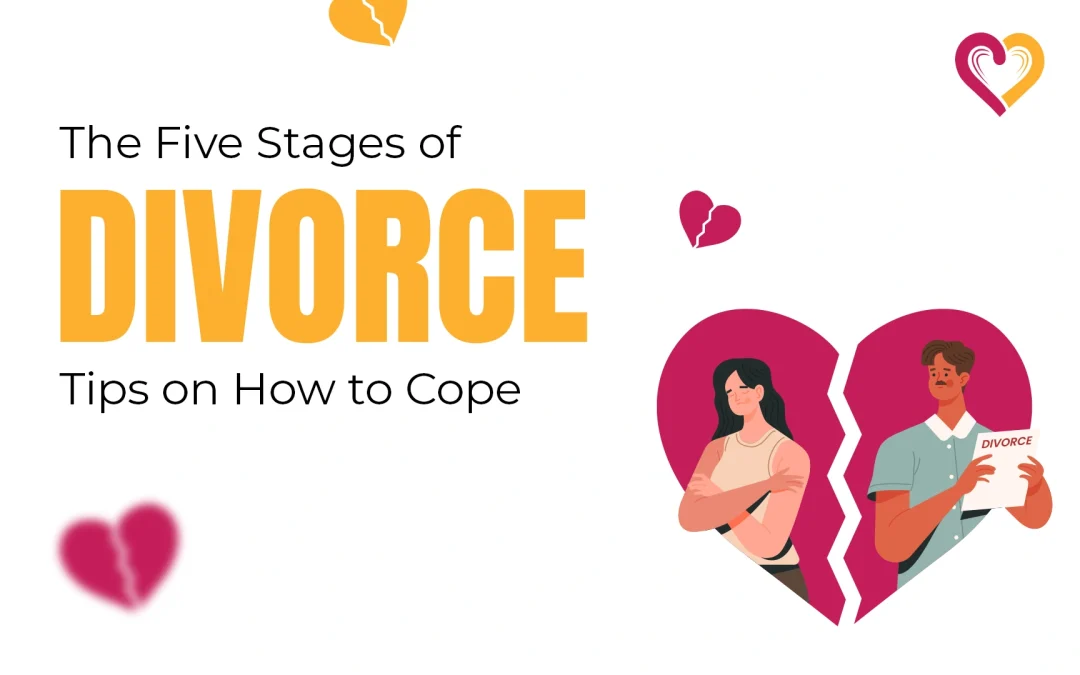Divorce is a difficult decision, but sometimes it’s the best choice for both the husband and wife. Since marriage begins with love and hopes, its end often feels like a real loss. No one plans for separation. So, when things don’t work out, it can be deeply painful. During this time, many people go through 5 stages of grief including denial, anger, bargaining, depression, and acceptance.
No doubt, divorce is one of the most stressful experiences a person can have. Even if both partners agree to part ways peacefully, it can still be hard to adjust and rebuild life. Knowing the stages of this process can make it easier to deal with emotions and start healing over time.
5 Stages of Divorce
We often talk about common divorce problems in Pakistan and around the world, but what couples go through after divorce isn’t discussed much. The 5 stages of divorce grief were introduced by Elisabeth Kübler-Ross in 1969. It’s completely normal to feel many different emotions during a divorce and to experience them at different times.
1. Denial
Denial is the first stage of grief. In this phase, a person may not believe there’s a serious problem or may think divorce won’t really happen. They hope things will get better or they avoid talking about it. This is common, especially for those who didn’t want a divorce.
The denial phase often shows through signs like shock, numbness, confusion, emotional shutdown, and avoiding the reality of the situation. Often, denial begins long before the divorce is mentioned, when one partner has been unhappy for a long time. It’s the mind’s way of protecting us from pain.
2. Anger
Once a person comes out of denial and accepts that the divorce is really happening, anger often follows. This is a natural reaction to such a big change in life. You may feel like the ground has been pulled from under you, leaving you unbalanced and overwhelmed. Many people look for someone to blame—often their spouse, family, friends, or even question their faith, wondering, “Why me?”
It’s okay to feel angry, but what matters is how you deal with it. Don’t bottle it up but also don’t let it control your actions. Expressing anger in a healthy way can help you heal and move forward without hurting yourself or your case.
3. Bargaining
The bargaining stage can deeply affect a person’s mindset and self-esteem. It’s when people start asking “what if” questions, like “What if I had tried harder?” or “What if I change?” They may even make promises in hopes of fixing the marriage. This is a normal part of the process, but it’s not always wise to trust promises made of fear or guilt.
Bargaining often brings guilt, blame, fear, anxiety, and constant overthinking. People may keep replaying past events, trying to find answers. While a small number of couples do reconcile, it’s important to be honest with yourself.
Talk to your spouse only if both are serious about making things work. During this phase, support from friends, family, or a therapist can really help you process your emotions and move forward.
4. Depression
No matter what the factors behind the rising divorce rate are, feeling deep sadness during a divorce is completely normal. Even if you are the one who decides to end the marriage, realizing that it’s truly over still brings emotional pain. As time goes on, reality sets in—life is changing, and it won’t be the same again.
This sadness often turns into depression. You may feel hopeless, helpless, low on energy, and lose interest in things you once enjoyed. You might stop socializing, struggle with sleep or appetite, or rely too much on medication to cope.
The depression phase is tough, but it doesn’t last forever. If you feel stuck or unable to move forward, it’s important to reach out for help. Talking to a mental health professional or using short-term medication is the right way to support you through this time and help you heal.
5. Acceptance
Acceptance is the final stage in the 5 stages of divorce. It’s when you start to heal and understand the changes in your life. You begin to see things more clearly and let go of the pain. Although the hurt is deep and takes time to heal, you finally come to terms with the fact that the relationship had to end this way.
You might even look back at the good moments in your marriage without feeling hurt, and slowly close that chapter.
In this stage, you learn to live on your own, maybe even as a single parent. Sadness starts to fade, and life begins to feel normal again. Even if you don’t fully accept everything, you learn to adapt and move forward.
Signs of acceptance include being more aware of your feelings, adjusting to the new life, being kind to yourself, handling emotions better, and feeling understood.
It’s time to spend a normal life again. Try a new hobby, go back to something you used to love, spend time with friends, read, or watch movies. Do what makes you happy as you begin this new phase of your life.
Endnote
Going through the 5 stages of divorce can bring many emotions, and that’s completely normal. Everyone’s experiences are different. No two people or divorces are the same. Still, knowing the general process can help you understand what you’re going through. If you feel stuck at any point, don’t hesitate to ask for help.
Divorce also gives you a chance to reflect on yourself, your habits, strengths, and areas for growth. It helps you understand how you reached this point and what changes you might want to make for the future. Use this time to learn, grow, and build a better version of yourself.
Frequently Asked Questions
What is the hardest stage of divorce?
The hardest stage of divorce is often depression, as it brings deep sadness, hopelessness, and a sense of loss. It’s when the reality of separation truly sinks in.
Who loses most in a divorce?
Kids often lose the most in a divorce, as it deeply affects their sense of security, routine, and emotional well-being.
How do men feel after divorce?
Men often feel the same emotions as women after a divorce—sadness, anger, loneliness, and confusion. They go through emotional pain too, but they may show it differently or find it harder to ask for help or talk about their feelings.
What type of couples divorce the most?
Couples who divorce the most often have poor communication, face financial stress, marry young without careful thought, and struggle with mismatched values or family pressure.
Who suffers the most after divorce?
Women often suffer the most after divorce, especially if the children are with them, as they must manage financial stability, care for the kids, and handle their own emotions.
Who regrets most after divorce?
Both men and women who rush into divorce without fully trying to resolve their issues tend to regret it the most. Those who feel unprepared or unsupported often experience even greater regret.


